PA art exhibit for Pope presents Palestinians as Jesus
PA exhibit for Pope presents
Palestinians as Jesus
Exhibit shows parts of classical paintings
of biblical scenes
merged with photos of Palestinians
Official PA presidential committee
requested the exhibit
by Itamar Marcus and Nan Jacques Zilberdik
For Pope Francis' visit to Israel and the Palestinian Authority next week, the PA has commissioned an art exhibit that includes works of art portraying Palestinians as Jesus.
The exhibit consists of visual displays merging classical paintings of biblical scenes with photos of Palestinians and have been "designed by the Palestinian Museum at the request of the Presidential Higher Committee for Church Affairs." [Al-Hayat Al-Jadida, May 20, 2014]
As Palestinian Media Watch has documented, the PA has misrepresented Jesus for years, claiming he was not a Judean as in Christian tradition, but rather a "Palestinian," thereby claiming a Palestinian history dating back to the time of Jesus. Mahmoud Abbas recently said Jesus was “a Palestinian messenger.” This exhibit reinforces the pretense that Jesus was a Palestinian by visually merging the image of Jesus in classical art with pictures of Palestinians.
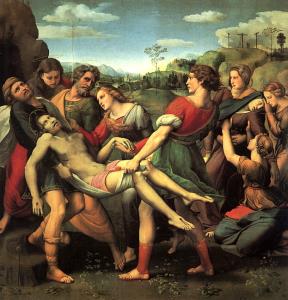 |
The Deposition (1507) |
Some of the displays at the exhibit also reiterate another PA message - that Palestinians suffer as Jesus did. (See museum's statement below.)
One example of such modified artwork is Raphael's The Deposition, (1507), which shows the dead Jesus being carried to his tomb. In the Palestinian version, Jesus' legs have been replaced by a photo of the wounded legs of a Palestinian, being carried away by a man as an Israeli soldier looks on.
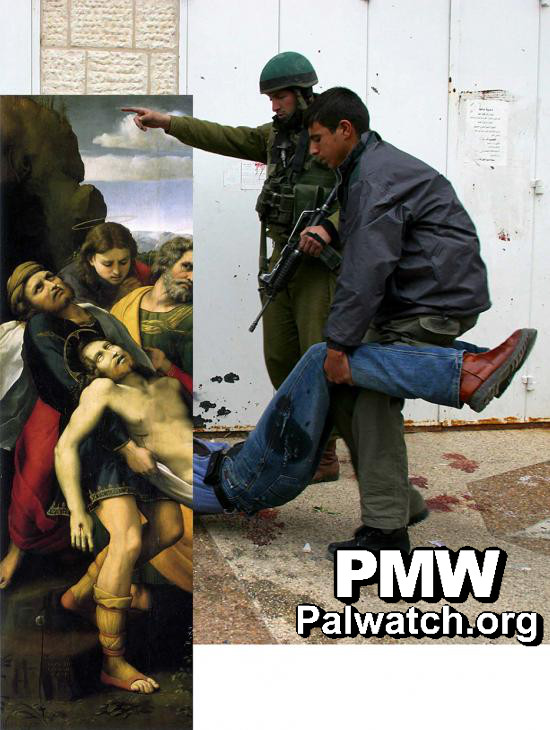 |
Palestinian modified version of The Deposition |
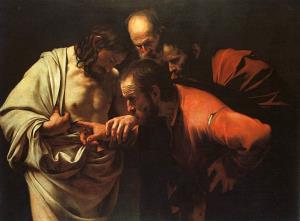 |
The Incredulity of Saint Thomas (1602) |
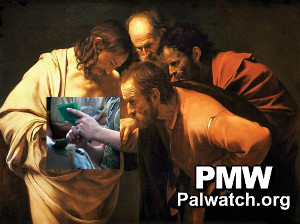 |
| Palestinian modified version of The Incredulity of Saint Thomas |
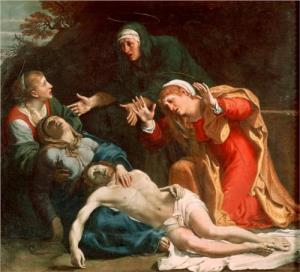
The Dead Christ Mourned (1606)
In Carracci's The Dead Christ Mourned (1606), which portrays the dead Jesus surrounded by mourners, Jesus has been replaced by a Palestinian woman standing in rubble, presumably after a bombing.
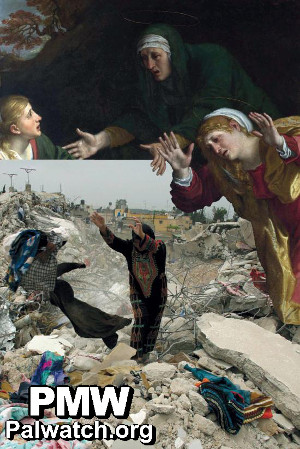 |
Palestinian modified version of The Dead Christ Mourned |
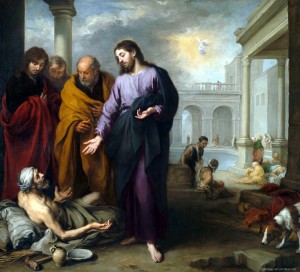 |
Christ healing the Paralytic at the Pool of Bethesda, (1670) |
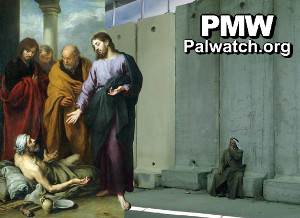 |
Palestinian modified version of Christ healing the Paralytic at the Pool of Bethesda |
Finally, in Rembrandt's The Sacrifice of Isaac, (1635), which shows the interfering angel and Abraham ready to cut Isaac's throat with a knife while covering his face with his hand, Abraham has been replaced by an Israeli soldier. 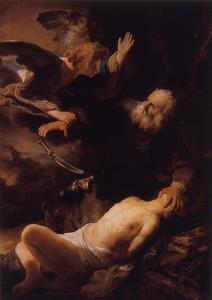 The Sacrifice of Isaac, (1635)
The Sacrifice of Isaac, (1635)
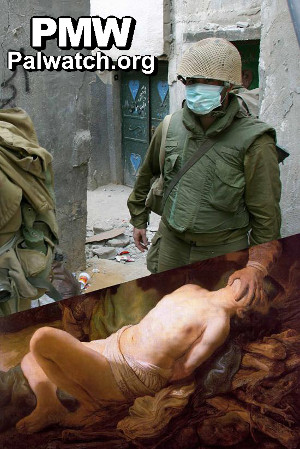 |
Palestinian modified version of The Sacrifice of Isaac, (1635) |
This Presidential Higher Committee for Church Affairs that initiated the exhibit is a PA institution "formed upon a decree issued by President Mahmoud Abbas," according to its website.
The following is the official PA daily's report on the PA exhibit for the Pope:
Headline: "The Palestinian Museum will welcome Pope Francis with visual displays that shed light on the life of our people in the shadow of the occupation"
"'Put your finger on the wound and be convinced of my existence' (based on John 20:27: 'Then saith he to Thomas, Reach hither thy finger, and behold my hands; and reach hither thy hand, and thrust it into my side: and be not faithless, but believing.' King James Bible) - this is the message with which the Palestinians will receive Pope Francis during his visit in Bethlehem on Sunday. This message will be illustrated with visual displays designed by the Palestinian Museum at the request of the Presidential Higher Committee for Church Affairs. The displays, in the shape of large signs and postcards, will be distributed throughout the Church of Nativity courtyard and the Deheisheh refugee camp throughout the week, to document the historic visit and shed light on the every-day life of the Palestinians in the shadow of the ongoing Israeli occupation.
The displays... were designed by combining famous classical Western paintings with newspaper photos from the archive of UNRWA (United Nations Relief and Works Agency for Palestine Refugees in the Near East). While the classical paintings were selected to represent scenes from the New Testament, which took place in Palestine in the distant past, the photographs reflect the painful reality the Palestinians have experienced and still experience under the occupation."
[Al-Hayat Al-Jadida, May 20, 2014]
The Palestinian Museum's description of the project:
Headline: "In the Presence of the Holy See Project"
"The Palestinian Museum is launching a new project in honour of Pope Francis's trip to Palestine. Banners combining recent media photographs of the Palestinian landscape and its people with Western baroque paintings of biblical scenes will decorate Manger Square in Bethlehem, highlighting the tension between the popular image of the Holy Land and Palestine's ongoing history of suffering under occupation and oppression."
[Palestinian Museum's website, http://www.palmuseum.org/exhibitions-news/news/in-the-presence-of-the-holy-see-project accessed May 22, 2014]